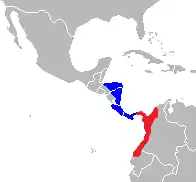Colombian white-faced capuchin
The Colombian white-faced capuchin (Cebus capucinus), also known as the Colombian white-headed capuchin or Colombian white-throated capuchin, is a medium-sized New World monkey of the family Cebidae, subfamily Cebinae. It is native to the extreme eastern portion of Panama and the extreme north-western portion of South America in western Colombia and northwestern Ecuador.[3]
| Colombian white-faced capuchin | |
|---|---|
 | |
| Scientific classification | |
| Domain: | Eukaryota |
| Kingdom: | Animalia |
| Phylum: | Chordata |
| Class: | Mammalia |
| Order: | Primates |
| Suborder: | Haplorhini |
| Infraorder: | Simiiformes |
| Family: | Cebidae |
| Genus: | Cebus |
| Species: | C. capucinus |
| Binomial name | |
| Cebus capucinus | |
 | |
| Distributions of Cebus capucinus (red)[2] and Cebus imitator (blue). C. capucinus is found in eastern Panama as well as South America. | |
The Colombian white-faced capuchin was one of the many species originally described by Carl Linnaeus in his landmark 1758 10th edition of Systema Naturae.[4] It is a member of the family Cebidae, the family of New World monkeys containing capuchin monkeys and squirrel monkeys. It is the type species for the genus Cebus, the genus that includes all the capuchin monkeys.[5]
Until the 21st century the Panamanian white-faced capuchin, Cebus imitator, was considered conspecific with the Colombian white-faced capuchin, as the subspecies C. capucinus imitator.[5] Some primatologists continue to consider the Panamanian and Colombian white-faced capuchins as a single species.[3] In 2012 a study by Boubli, et al demonstrated that C. imitator and C. capucinus split up to 2 million years ago.[6][7] Although the Panamanian white-faced capuchin is the most well-studied capuchin monkey species, as of 2014 there had been no field studies of the Colombian white-faced capuchin.[7]
Two subspecies of Colombian white-faced capuchin are recognized:[3][8]
- C. c. capucinus, from mainland South America and Panama
- C. c. curtus, from the Pacific island of Gorgona, sometimes referred to as the Gorgona white-faced capuchin.
Like other monkeys in the genus Cebus, the Colombian white-faced capuchin is named after the order of Capuchin friars because the cowls of these friars closely resemble the monkey's head coloration.[9][10] The coloration is black on the body, tail, legs and the top of the head, with white chest, throat, face, shoulders and upper arms.[3] The head and body length is between 33 and 45 cm (13 and 18 in) with a tail length of between 35 and 55 cm (14 and 22 in).[3] Males weigh between 3 and 4 kg (6.6 and 8.8 lb), while females are about 27% smaller, weighing between 1.5 and 3 kg (3.3 and 6.6 lb).[3] C. c. curtus has a shorter tail.[8]
The white-faced capuchin is found in the extreme north-western strip between the Pacific Ocean and the Andes Mountains in Colombia and northwestern Ecuador.[2]
C. c. capucinus has been listed as endangered from a conservation standpoint by the IUCN, while C. c. curtus has been listed as vulnerable.[1][11]
References
- de la Torre, S.; Moscoso, P.; Méndez-Carvajal, P.G.; Rosales-Meda, M.; Palacios, E.; Link, A.; Lynch Alfaro, J.W.; Mittermeier, R.A. (2021). "Cebus capucinus". IUCN Red List of Threatened Species. 2021: e.T81257277A191708164. doi:10.2305/IUCN.UK.2021-1.RLTS.T81257277A191708164.en. Retrieved 13 November 2021.
- Rylands, A.; Groves, C.; Mittermeier, R.; Cortes-Ortiz, L. & Hines, J. (2006). "Taxonomy and Distributions of Mesoamerican Primates". In Estrada, A.; Garber, P.; Pavelka, M. & Luecke, L (eds.). New Perspectives in the Study of Mesoamerican Primates. New York: Springer. pp. 40–43. ISBN 978-0-387-25854-6.
- Mittermeier, Russell A.; Rylands, Anthony B. (2013). Mittermeier, Russell A.; Rylands, Anthony B.; Wilson, Don E. (eds.). Handbook of the Mammals of the World: Volume 3, Primates. Lynx. pp. 412–413. ISBN 978-8496553897.
- Linnaeus, C (1758). Systema naturae per regna tria naturae, secundum classes, ordines, genera, species, cum characteribus, differentiis, synonymis, locis. Tomus I. Editio decima, reformata (in Latin) (10th ed.). Holmiae. (Laurentii Salvii). p. 29.
- Groves, C. P. (2005). Wilson, D. E.; Reeder, D. M. (eds.). Mammal Species of the World: A Taxonomic and Geographic Reference (3rd ed.). Baltimore: Johns Hopkins University Press. p. Cebus. ISBN 0-801-88221-4. OCLC 62265494.
- Boubli, Jean P.; et al. (2012). "Cebus Phylogenetic Relationships: A Preliminary Reassessment of the Diversity of the Untufted Capuchin Monkeys" (PDF). American Journal of Primatology. 74 (4): 1–13. doi:10.1002/ajp.21998. PMID 22311697. S2CID 12171529. Archived from the original (PDF) on 2016-03-04. Retrieved 2018-12-30.
- Lynch Alfaro, Jessica; et al. (2014). "Capuchin Monkey Research Priorities and Urgent Issues" (PDF). American Journal of Primatology. 76 (8): 1–16. doi:10.1002/ajp.22269. PMID 24668460. S2CID 14778572. Archived from the original (PDF) on 2017-08-10. Retrieved 2018-12-30.
- Phillips, Kimberly A. (2016). Rowe, Noel; Myers, Marc (eds.). All the World's Primates. Pogonias Press. pp. 283–284. ISBN 9781940496061.
- "Capuchin Franciscans F.A.Q." Capuchin Franciscans Vocation Office Province of Saint Joseph. Archived from the original on 2011-07-25. Retrieved 2008-09-01.
- Wainwright, M. (2002). The Natural History of Costa Rican Mammals. Zona Tropical. pp. 135–139. ISBN 978-0-9705678-1-9.
- Palacios, E.; Mittermeier, R.A.; Lynch Alfaro, J.W. (2020). "Cebus capucinus ssp. curtus". IUCN Red List of Threatened Species. 2020: e.T4087A17981356. doi:10.2305/IUCN.UK.2020-3.RLTS.T4087A17981356.en. Retrieved 13 November 2021.
